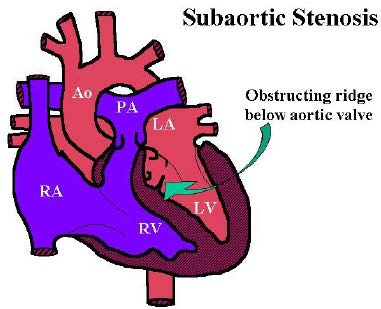Table of Contents
Definition | Symptoms | Types | Diagnosis | Treatment | Prevention
What is Aortic Stenosis in Dogs:
Aortic stenosis is one of the most common congenital heart diseases in dogs. it occurs when a heart valve narrows, causing the left ventricle of the heart to pump harder. When a dog's left ventricular outflow tract contracts, it pushes newly oxygenated blood through the valve. In dogs with aortic stenosis, the ventricle pushes harder to move the same amount of blood through the narrowing valve. If not treated, the change in the aortic flow velocity condition can result in heart failure or death.

What Are the Symptoms?
Aortic Stenosis develops over time and may not cause noticeable symptoms until the condition is severe. The first sign is often a heart murmur caused by abnormal blood flow that is detected by a veterinarian. Related clinical signs include:
- Congestive heart failure causes a dog to die suddenly, particularly during exercise if too active
- Collapse
- Fainting (syncope)
- Cough
- Difficulty breathing
- Exercise intolerance such as collapse during exercise
- Some cases can lead to lung congestion and fluid leakage in surrounding tissues (congestive heart failure or CHF)
At Risk Breeds
Large breed dogs are at increased risk, but any dog can inherit the condition. Puppies with a heart murmur will be tracked over time to see if the murmur worsens or goes away.
Breeds at risk include:
- Bouvier des Flanders
- Boxer
- English Bulldog
- German Shepherd
- German Shorthair Pointer
- Golden Retriever
- Great Dane
- Newfoundland
- Rottweiler
- Samoyed
What Are the Types of Dog Aortic Stenosis?
There are three types of aortic stenosis based on the location of the congenital heart defects. All can be characterized based on the disease severity; such as mild affected or mild forms, moderate, or severe disease such as a case of severe subaortic stenosis
- Supravalvular aortic stenosis: Describes a narrowing above the aortic valve.
- Valvular aortic stenosis: When the valve narrows.
- Subaortic stenosis: Narrowing beneath the aortic valve.
Your dog's prognosis will be based on the severity of the disorder, regardless of characterization. Dog's with mild cases can expect to live a normal lifespan. Severely affected dogs with more severe conditions have a worsening prognosis.
Diagnosis
There are several tests that are used to reach a diagnosis:
- X-Rays: used in mild cases to see if there were any changes in the heart.
- Echo (echocardiogram): This is a heart ultrasound that uses doppler echocardiography and is the ideal way to get a definitive diagnosis to see if aortic stenosis exists. An echo can also be used to check condition severity.
- Blood tests: used to determine if medications are needed.
Treatment
If the aortic stenosis is mild it does not require treatment. If the case is moderate to severe treatment is required. The condition cannot be cured, but it can be managed.
Medication and Lifestyle Modification
Treatment is usually accomplished with changes to lifestyle such as exercise restriction and the avoidance of severe extortion. Medications such as beta-blockers (Atenolol) can decrease the force that the heart is using during contractions.
Depending on how your dog responds, other medications such as antiarrhythmic are used. Medications are taken for life.
If your dog is exercise restricted ask if your dog can participate in low-impact activities that do not result in hard panting such as walks. Games such as fetch may not be appropriate for dogs with aortic stenosis.
Surgery
Surgical procedures have achieved mixed results. One procedure with promise is "cutting balloon valvuloplasty." The procedure uses a balloon that is inserted into the carotid artery and moved into the restricted area of the heart. A second balloon is then used to dilate the vessel. The issue is that some treated dogs re-develop a narrowing of the valve within one to two years after the procedure. The procedure could also damage the aortic valve.
Open heart surgery is generally not performed due to the cost, procedure complexity, and need for cardiopulmonary bypass.
Does Medicine or Surgery Improve Outcomes?
It is beneficial to give dogs diagnosed with moderate to severe forms of this common congenital heart defect. Studies show that treatment of any kind will improve a dog's quality of life and prolong survival. While treatment does improve clinical signs, studies have shown that treatment does not diminish the chance of sudden death. When comparing surgery to the exclusive use of medications, there was no significant difference in physiological parameters or survival times.(1)
Canine Congenital Aortic Stenosis Prevention
Prevention starts with breeding and the avoidance of partners with congenital heart disease or any other common congenital heart defects. Ask your breeder about the litter's relatives and if there is any genetic evidence of disease. Has your new puppy been checked by a veterinarian for this condition? If a new puppy has a heart murmur, an electrocardiogram can be used to check heart health.
References
- Does medical or surgical treatment for aortic stenosis improve outcomes in dogs?; Author(s): Thomas J., Marshall S., Gormley K..;In: Veterinary Evidence - Vol 6 N°2, Jun 2021 by Veterinary Evidence
